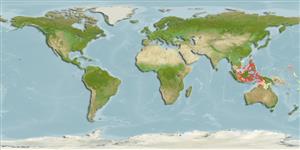>
Ovalentaria/misc (Various families in series Ovalentaria) >
Opistognathidae (Jawfishes)
Etymology: Opistognathus: Greek, opisthe = behind + Greek, gnathos = jaw (Ref. 45335); to the very elongate upper jaw of the type species of the genus, Opistognathus nigromarginatus (Ref. 128653); randalli: Named for Dr. John E. Randall.
Eponymy: Dr John ‘Jack’ Ernest Randall Jr. [...] (Ref. 128868), visit book page.
Environment: milieu / climate zone / depth range / distribution range
Ecologia
marinhas; intervalo de profundidade 5 - 32 m (Ref. 81517). Tropical
Western Pacific: Indonesia, eastern Borneo and the Philippines.
Tamanho / Peso / Idade
Maturity: Lm ? range ? - ? cm
Max length : 10.4 cm SL macho/indeterminado; (Ref. 81517); 10.9 cm SL (female)
Descrição breve
Chaves de identificação | Morfologia | Morfometria
Espinhos dorsais (total) : 11; Raios dorsais moles (total) : 14 - 16; Espinhos anais: 3; Raios anais moles: 14 - 15; Vértebras: 28. This species is distinguished by the following characters: elongate supramaxilla and posterior end of maxilla produced as a thin flexible lamina; a single conspicuous black stripe at inner lining of upper jaw and adjacent membranes; dorsal, anal and caudal fins with narrow, pale (blue in life) distal margins; when alive, dorsal portion of iris golden; lateral-line terminus below verticals between segmented dorsal-fin rays 1 to 4, typically below second to third ray; caudal vertebrae 18 (Ref. 81517).
Males of this species are strongly territorial and frequently engage in jaw locking combat, apparently to evict rivals or confiscate their burrows (Ref. 81517). Found in sand/rubble bottoms near reefs in about 5-30 m (Ref 90102).
Life cycle and mating behavior
Maturidade | Reprodução | Desova | Ovos | Fecundidade | Larvas
Smith-Vaniz, W.F., 2009. Three new species of Indo-Pacific jawfishes (Opistognathus: Opistognathidae), with the posterior end of the upper jaw produced as a thin flexible lamina. aqua, Int. J. Ichthyol. 15(2):69-108. (Ref. 81517)
Categoria na Lista Vermelha da IUCN (Ref. 130435: Version 2024-2)
Ameaça para o homem
Harmless
Utilização humana
Ferramentas
Relatórios especiais
Descarregue XML
Fontes da internet
Estimates based on models
Preferred temperature (Ref.
123201): 28.4 - 29.3, mean 28.8 °C (based on 778 cells).
Phylogenetic diversity index (Ref.
82804): PD
50 = 0.5000 [Uniqueness, from 0.5 = low to 2.0 = high].
Bayesian length-weight: a=0.00389 (0.00180 - 0.00842), b=3.12 (2.94 - 3.30), in cm total length, based on all LWR estimates for this body shape (Ref.
93245).
Nível Trófico (Ref.
69278): 3.5 ±0.6 se; based on size and trophs of closest relatives
Fishing Vulnerability (Ref.
59153): Low vulnerability (10 of 100).
Nutrients (Ref.
124155): Calcium = 326 [174, 606] mg/100g; Iron = 1.61 [0.92, 2.70] mg/100g; Protein = 17.8 [16.7, 18.8] %; Omega3 = 0.174 [0.091, 0.341] g/100g; Selenium = 32.4 [13.1, 73.7] μg/100g; VitaminA = 46.5 [14.7, 144.0] μg/100g; Zinc = 2.27 [1.56, 3.22] mg/100g (wet weight);
